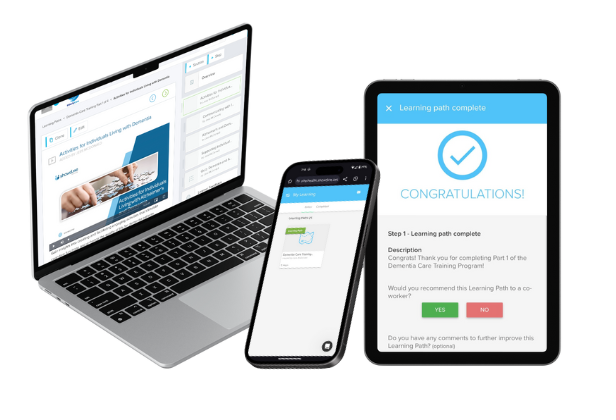How to improve online training in Spanish (and why you should!)
Post - How to improve online training in Spanish (and why you should!)
This Hispanic Heritage Month is an important time to review your online training for Spanish-speaking employees
The need for Spanish language job training in the U.S. is growing exponentially. By 2024, it’s estimated that Hispanics will make up 32.5 percent of the total U.S. workforce. Here are the numbers from the Department of Labor:
-
1990: 10.7 million
-
2020: 29 million
-
2030: 35.9 million (projected)
Outside of Mexico, the U.S. has the second-largest population of Spanish speakers in the world. In the healthcare and hospitality industries, Spanish-speaking employees make up a significant portion of the workforce. According to the Department of Labor, Hispanics already account for more than 22% of the employees in hospitality.
Meeting the training, professional development and compliance needs of the Spanish-speaking population means creating Spanish-first content.
Spanish-first content takes more than just adding subtitles or a Spanish voiceover to a video. It requires creating engaging content with the help of native Spanish speakers.
This Hispanic Heritage Month, we at showd.me are focusing on why you should offer online training in Spanish and how to make it engaging for the many Spanish-speaking employees working in home health, skilled nursing facilities and hospitality industries.
Engaging online training in Spanish leads to better health outcomes
According to Home Health Care News, having multilingual caregivers is crucial to providing care for patients who are not native English speakers. Reducing language and cultural barriers by having Spanish-speaking caregivers for Spanish-speaking patients leads to more positive outcomes and lower hospitalization rates. “As the makeup of the United States continues to shift, with one in five U.S. households speaking a language other than English at home, the demand for language-concordant home health care services is likely to rise.”
About eight-in-ten (81%) Hispanic adults who are Spanish language dominant prefer to see a Spanish-speaking healthcare provider to reduce communication issues in receiving medical care, according to Pew Research. This underscores the need for well-trained Spanish-speaking caregivers to serve the health needs of this population.
Meeting the growing needs of Spanish-speaking clients and patients requires simple hiring and onboarding practices, as well as maintaining well-trained staff. Making hiring paperwork and onboarding training in Spanish speeds up hiring for those who communicate primarily in Spanish.
At showd.me, we offer easy-to-use online applications and onboarding forms in multiple languages to accelerate hiring processes.
Improve cultural competency with online training in Spanish
Cultural competency training improves work culture and interactions with clients and patients. The training should cover topics like sensitivity, respect, unconscious bias and mentoring.
The National Standards for Culturally and Linguistically Appropriate Services (CLAS) outlines standards to ensure workplaces are equitable. The standards should guide every point of contact from hiring to training. Cross-cultural communication skills include the following:
- Improve cultural and linguistic appropriateness
- Be aware of language differences
- Design written materials purposefully
- Don’t make assumptions
- Avoid jargon
- Recognize differences in communication styles
5 tips for successful Spanish-speaking training programs
When it comes to multilingual online training, several factors determine whether the initiative is successful. Following are five tips to improve compliance training content in Spanish.
- Use a human translator: Simply translating English content into Spanish can mean the material remains awkward and even unclear. It’s important to have a native speaker edit any content you develop through a translation service or app.
- Multilingual help desk: When your Spanish-speaking employees need support logging into their accounts or accessing material, they should be able to ask questions in Spanish. showd.me offers live online support in multiple languages, including Spanish.
- Make the content engaging: Using subtitles or a voiceover makes watching any video training content tedious and challenging to absorb. Many training companies, like showd.me, produce content directly with Spanish-speaking narrators.
- Use a common dialect: Spanish has many different words, dialects and expressions depending on where the speaker is from. It’s best to identify the most common regions represented in your workforce and create content based on that culture.
- Translate evaluation material and instructions: It’s not only training videos that should be designed in Spanish. Any material employees need to access should be in multiple languages as well.
In addition to Spanish, showd.me’s engaging and professionally translated content can be accessed in multiple languages on our easy-to-use platform, helping employees get up and running faster. We also offer white glove multilingual customer support via chat, email or text.
Creating a culturally competent workplace is essential for any company. Offering Spanish-speaking professional development opportunities can be an effective way to demonstrate this commitment and give healthcare and hospitality companies a competitive advantage.

Let Us Show You More
See how showdme's unique service-first approach to training helps hundreds of healthcare organizations ensure compliance. Request a demo today!

